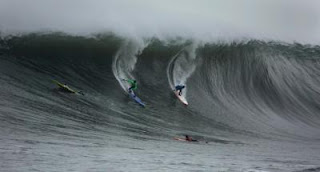After much wishful thinking in recent weeks, the Bay Area's big-wave surfing bash was finally caught in the undertow, getting called off today for the second time in three years.
Organizers are looking at ways to sidestep poor wave-producing winters, namely opening the window Nov. 1 to take advantage of the North Pacific's meteorological sweet spot. The sponsors who put up a record $150,000 in prize money are expected to remain on board for next year.
And, perhaps most important in the eyes of the 24 invited surfers, the sanctity of a modern natural wonder wasn't compromised.
"Everyone I talk to says the same thing: If it's not absolutely solid, just don't even do it," contestant Zach Wormhoudt of Santa Cruz said recently.
In previous years, the contest window opened in November or December. But this event got off to a tardy start — early January — when the pre-recession ripples made it difficult to lock in sponsorship commitments. By the time a promising mid-January swell had fizzled along the San Mateo coast, those who track Mavericks' every hiccup were doubtful a contestable swell would emerge before the March 31 deadline. A La Niña condition had put its clamps on the storm track, shutting down all but a few pulses for the California coast and Hawaii.
By the time a promising mid-January swell had fizzled along the San Mateo coast, those who track Mavericks' every hiccup were doubtful a contestable swell would emerge before the March 31 deadline. A La Niña condition had put its clamps on the storm track, shutting down all but a few pulses for the California coast and Hawaii.
"It's going to be tough. The models just don't look very good at all," official Mavericks surf forecaster Mark Sponsler said at the time.
When the predictions proved accurate, and a swell targeting Northern California for Monday emerged, organizers hoped to extend the contest window another week.
But today, the white flag was waved — largely because of environmental concerns expressed by the Gulf of the Farallones National Marine Sanctuary. It was feared bringing thousands out to the coast for the one-day event during the breeding season for seabirds and marine mammals could have a negative impact.
"The presence of listed and vulnerable species, newly born harbor seal pups, migrating whales, and nesting birds make April a particularly sensitive time," GFNMS Superintendent Maria Brown said in Mavericks press release. "Any wildlife disturbance by boats, people on foot, and aircraft can result in mortality. Wildlife conservation is a concern throughout the entire year, but especially serious consequences can result if vulnerable species are not able to breed successfully at critical times during the year, including right now."
Even without the environmental concerns, the swell models examined by Sponsler and others suggest the storm will track too far north to target Mavericks and probably be accompanied by chop-inducing north winds. Instead, organizers will set their sights on a Nov. 1 start seven months from now.
Mavericks Surf Ventures CEO Keir Beadling said increased sponsorship commitments from others beyond Campbell-based Barracuda Networks and Moose Guen of MVision will be key in extending the window.
"It is my hope that the additional sponsorship support we'll need to officially announce a Nov. 1 opening will be forthcoming," Beadling said via e-mail. "I'm working on that."
Only five significant swells — energy masses that have enough size and duration to create mountains of water at Mavericks — pushed through all winter. During the average winter, the storm track produces three times that amount. And the bullish El Niño years of the late 1990s would produce upwards of 30.
"The worst year ever," contest director Jeff Clark called it in March.
But throwing a big-wave surf contest is largely an act of faith. The window for the Eddie Aikau Invitational on Oahu's North Shore closed in February, leaving the event grounded for the fifth consecutive year. In its 23 years of existence, the Eddie has been contested only seven times.
Langganan:
Posting Komentar (Atom)
0 komentar
Posting Komentar